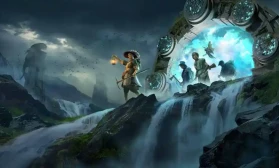Title: Beyond the Sign: How "Landslide Shelter Sign Installer Simulator VR" Place Missions DLC Redefines Empathy in Gaming
The virtual reality landscape is often dominated by the fantastical—swords clashing against dragons, starships weaving through asteroid fields, and spells crackling in the air. It’s a realm of escape. Yet, a unique and quietly profound subgenre has emerged: the simulator. These games find compelling narratives not in epic quests, but in the meticulous execution of mundane tasks. "Landslide Shelter Sign Installer Simulator VR" (LSSIS VR) stands at the apex of this movement, and its new "Place Missions" DLC doesn't just add content; it completes a transformative vision, turning a technical job into a deeply human experience.

The base game of LSSIS VR was a masterclass in mundane immersion. Players were tasked with navigating treacherous, post-landslide terrain in a fictional, mountainous region to install vital signage: directional arrows to shelters, hazard warnings for unstable ground, and capacity notices for emergency facilities. The core gameplay loop was satisfyingly tactile. You’d physically reach over your shoulder to grab a signpost from your backpack, feel the rumble of the VR controllers as you used a virtual mallet to drive it into the hard earth, and carefully align the sign for maximum visibility. It was a meditative, almost therapeutic experience, underscored by a sobering awareness of your role. You weren’t a hero stopping the disaster; you were a responder helping to manage its aftermath.
The "Place Missions" DLC, however, shifts the focus from the sign to the space. It introduces a new layer of objectives that are less about instruction and more about connection. This is where the simulator transcends its mechanics and becomes something far more significant.
The Mechanics of Meaning
The DLC introduces three new mission types, each designed to engage a different emotional and cognitive faculty:
-
Memorial Placement: The most emotionally charged addition. You are no longer just installing standardized signs. You are given a small, handcrafted wooden marker or a durable plastic placard with a specific name on it. Your task is to find the designated location—often a place of personal significance now buried under mud and rock, like the foundation of a home or a beloved community garden—and place the memorial. There is no mallet, no loud pounding. The interaction is a soft, solemn push into the earth or a gentle attachment to a remaining structure. The sound design here is critical: the frantic radio chatter of the base game is replaced by the whisper of the wind and the distant sound of recovery machinery. This mission type forces a moment of pause and reflection, asking the player to acknowledge individual loss within the larger-scale catastrophe.
-
Hope Marker Installation: In stark contrast to the memorials, these missions are about the future. You are tasked with placing bright, colorful markers—often flags or small, solar-powered beacons—on areas that recovery teams have just cleared and deemed safe for rebuilding. The act of placing them is simple, but the context gives it immense weight. You are literally planting the first seeds of hope, signifying that the healing process is moving from response to recovery. It’s a powerful, optimistic counterpoint that prevents the experience from becoming overwhelmingly grim.
-
Resource Wayfinding Optimization: This mission type appeals to the logistical brain. The DLC introduces a new, more complex shelter environment—a sprawling, makeshift tent city that has evolved organically and is now a maze of confusion for displaced residents. Your job is not to place new signs, but to analyze the flow of people and the location of critical resources (medical tents, food distribution, childcare) and reposition existing signage for maximum efficiency. You must watch virtual residents get lost, see bottlenecks form, and then use your expertise to solve these problems. It’s a puzzle game layered on top of the simulator, emphasizing that your work has a direct, observable impact on the well-being of others.
The Empathetic Loop
The genius of the "Place Missions" DLC lies in what it withholds as much as what it provides. You never see the faces of the people you are helping in any detailed way; they are often silhouettes or blurred figures in the distance. You hear their voices only as muffled conversations or over a radio. This abstraction is intentional. It prevents melodrama and instead allows the player’s imagination to fill the gaps, creating a more personal and potent form of empathy. You are not told to feel sad; you are given a task whose solemnity naturally inspires reflection. You are not told to feel hopeful; you perform an action that symbolizes a new beginning.
The VR medium is the perfect conduit for this experience. The sense of scale is palpable. Looking up at a massive wall of earth that once was a hillside, or down into a valley filled with the debris of people’s lives, is humbling in a way a flat screen could never achieve. The physical act of kneeling to place a memorial, of stretching to mount a sign on a high pole, or of carefully navigating a slippery path makes you feel present and responsible.
A New Standard for "Serious Games"
The "Place Missions" DLC solidifies LSSIS VR’s status as more than a game; it is a nuanced piece of interactive storytelling. It belongs to a new wave of "empathy games" but executes its goal with a subtlety and maturity that avoids preachiness. It doesn’t tell you about the importance of disaster response; it makes you live a small, crucial part of it.
By focusing on the quiet, often overlooked tasks that follow a tragedy, this DLC achieves a rare feat. It demonstrates that in a medium obsessed with power fantasies, there is profound power in powerlessness. You cannot lift the rubble with your hands or stop the rain, but you can perform your small duty with care, respect, and precision. And in doing so, "Landslide Shelter Sign Installer Simulator VR: Place Missions" makes a compelling case that sometimes, the most heroic act is simply to bear witness and to show others the way forward.
Tags: #VRGaming #SimulatorGames #GameReview #VRSafetyTraining #EmpathyInGaming #SeriousGames #DisasterResponse #IndieGames #GamingInnovation #LandslideSimulator












